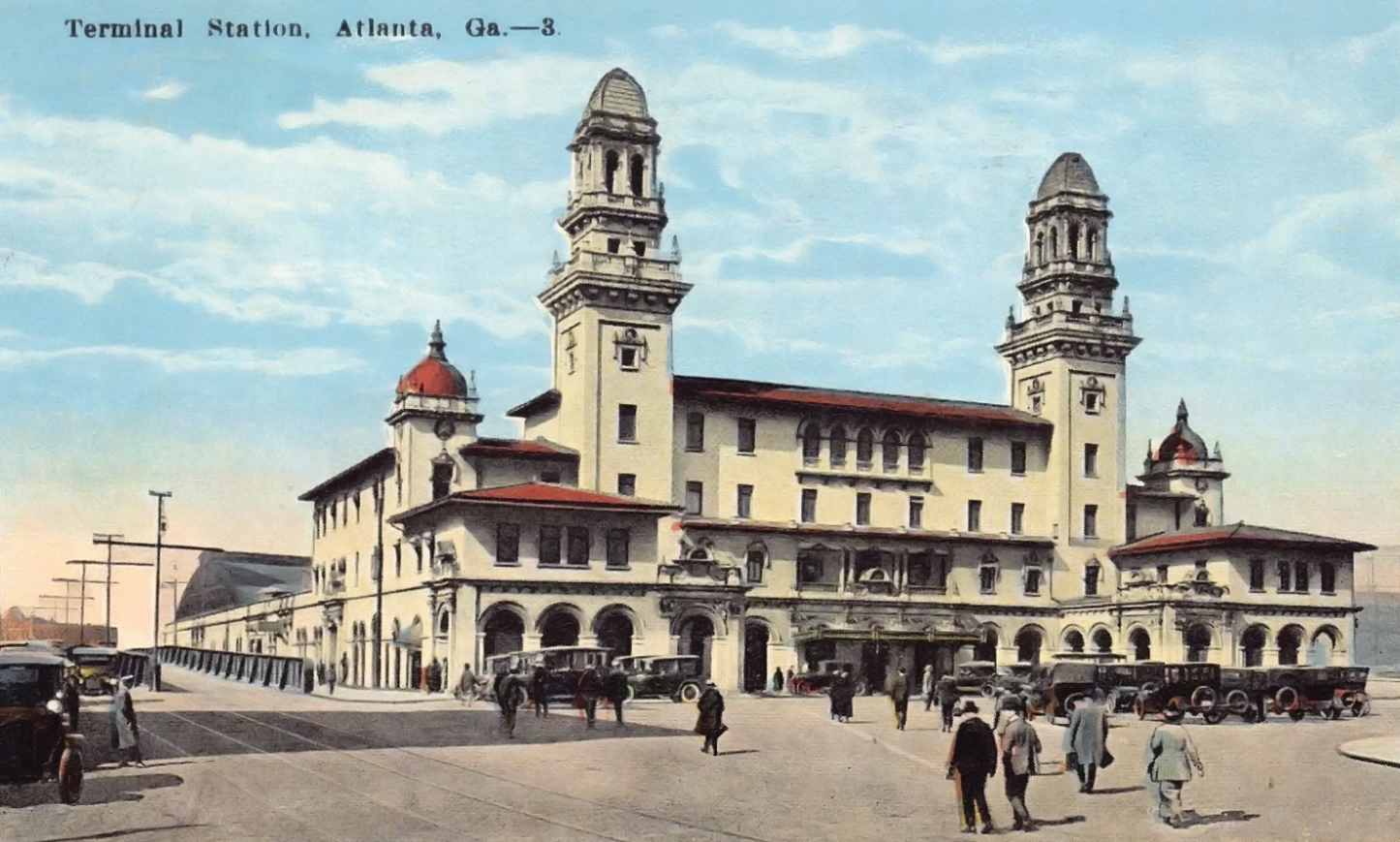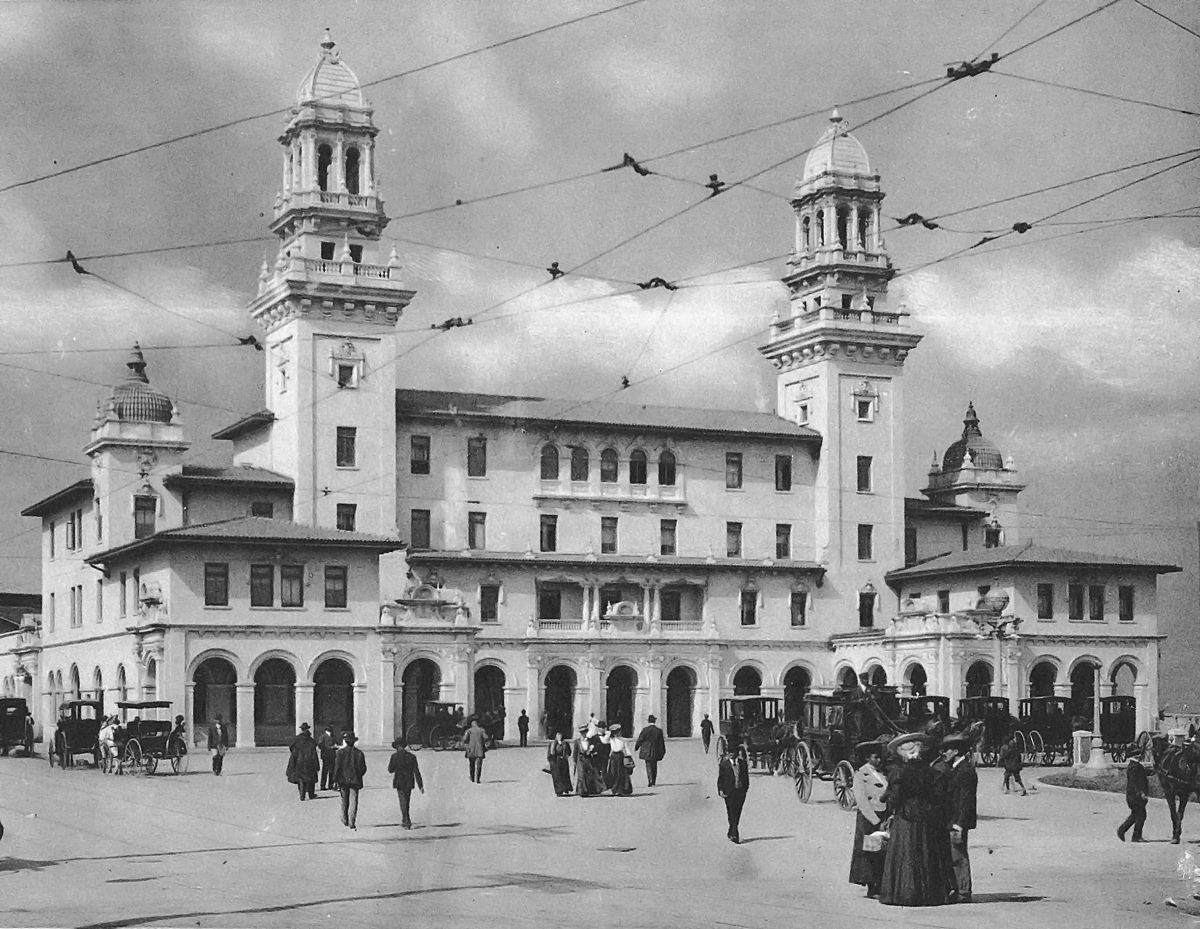Terminal Station (Atlanta): History, Photos, Legacy
Published: February 8, 2025
By: Adam Burns
The history of Atlanta's Terminal Station encapsulates both the growth of a city and the evolution of American rail travel. Opened in the early 20th century, the facility was not only a significant piece of architecture but also a bustling hub of transportation that shaped the socio-economic landscape of Atlanta and the wider region.
Terminal Station was the more expansive of the two significant terminals serving the heart of Atlanta (Union Station). Inaugurated in 1905, the station accommodated the Southern Railway, Seaboard Air Line, Central of Georgia, and Atlanta & West Point (West Piont Route).
Understanding its historical significance provides a window into the transformative nature of transportation infrastructure in urban development.
Origins: A Growing Need for a Terminal
By the late 19th century, Atlanta had emerged as a critical railroad junction, due in large part to its strategic location as a transportion link between the southeastern United States and other parts of the country, from the northern East Coast to the Appalachian Mountain interior (Chattanooga).
The lower stretch of the Piedmont Plateau and the Appalachians nestled Atlanta into an ideal transshipment point, attracting numerous railroads seeking to capitalize on the booming cotton, textiles, and manufacturing industries.
Prior to the construction of Terminal Station, Atlanta was served by Union Station, opened in the 1850s, which quickly proved inadequate to handle the increasing passenger traffic.
The burgeoning demand for a larger, more modern facility was evident. This demand set the stage for Terminal Station's construction, which aimed to establish a more accommodating and architecturally grander facility consistent with the aspirations of a burgeoning southern metropolis.
Construction and Architecture
The station was commissioned by the Southern Railway in collaboration with the Central of Georgia and the Atlanta & West Point railroads. Construction began in 1903, and the grand opening ceremony took place on May 1, 1905.
The station's location at the intersection of Spring and Mitchell streets was strategic, embedding it within Atlanta’s central business district and making it accessible to a wide range of commuters.
Designed by the renowned architectural Washington firm P. Thornton Marye - and built by the Atlanta-based contracting firm Gude & Walker - the station boasted a fascinating Beaux-Arts style, which was the architectural vernacular of grand public buildings of the time.
Its most distinguishing feature was its imposing arched entranceway, flanked by classical columns and capped with a grand dome, reminiscent of classical Roman architecture.
The interior was equally opulent, adorned with marble, ornate plasterwork, and expansive waiting rooms, reflecting both the technological sophistication and the aspirational spirit of turn-of-the-century America.
Upon its inauguration, the musical accompaniment for the station's opening was provided by the military band of the 16th Infantry Regiment, which performed "Down in Dixie," as reported by the Atlanta Journal.
On May 21, 1910, the station became home to a statue commemorating Samuel Spencer, the inaugural president of Southern Railway, which remained in place until the facility ceased operations.
The Golden Age of Rail Travel
The facility was a pivotal transportation hub in the American Southeast, functioning as a crucial connection between the warm regions of Florida and the Gulf Coast and the cooler, more densely populated areas of the Northeast and Midwest.
For many Northeastern residents, it represented the portal to sunnier climes. In the 1920s, the Atlanta Convention Bureau released a postcard boasting that Terminal Station accommodated 86 trains daily.
During the streamlined era it hosted renowned trains such as the Crescent, Man o' War, Nancy Hanks, Ponce de Leon, and Silver Comet.
Parallel to this bustling activity, Terminal Station played host to myriad historical events. It was a poignant departure point for soldiers heading off to both World War I and World War II, and a beloved greeting location for loved ones returning from service. The presence of the station became a staple of collective memory for many Atlantans during these eras.
Decline and Demolition
The post-World War II era marked the beginning of the station’s decline. With the rise of automobiles and the establishment of national highway systems, the popularity and necessity of rail travel began to wane. The proliferation of commercial air travel in the mid-20th century further compounded this trend.
With dwindling passenger numbers, Terminal Station faced an inevitable financial struggle. By the mid-1960s, the facility was no longer economically viable. The decline was inexorable, and despite its architectural significance, Terminal Station became a casualty of progress. In a poignant reflection of the Atlantic railway network’s transformation, the once-thriving concourses grew quiet.
Following the station's closure in June 1970, the Southern Railway continued to run its Southern Crescent and Piedmont services through the smaller Peachtree Station, also referred to as Brookwood Station, which was initially constructed as a suburban stop, now serving as Atlanta’s sole rail stop.
The Nancy Hanks, the only other passenger service previously utilizing the station at the time, resorted to using a makeshift ticket office and waiting area within the adjacent Southern office building.
Efforts to preserved the complex ultimately failed and it was sadly demolished in 1972, with the Richard B. Russell Federal Building now occupying the site.
This demolition was part of a broader pattern of urban renewal and modernization efforts during the era, which were often indifferent, if not outright hostile to historical preservation.
The last remnants of the station included an interlocking tower and a section of one platform, both retained by Southern Railway. The tower was demolished in June 2018, followed by the removal of the platform in November 2019.
Legacy and Remembrance
Today, the crown dome and terrestrial expanse of Terminal Station remain only in photographs, memories, and history books. Although its physical existence was short-lived, the impact of Terminal Station on the development of Atlanta—and the American South more broadly—remains indelible.
The site's erasure reminds us of the delicate balance between progress and preservation, and the station's historical narrative continues to serve as a poignant reflection on urban development in 20th-century America.
This narrative contributes to ongoing conversations about historic preservation and the role of infrastructure in shaping both the physical and cultural landscape of a city.
Recent Articles
-
Oregon Railroad Museums: A Complete Guide
Apr 25, 25 03:11 PM
With its rich tapestry of scenic landscapes and profound historical significance, Oregon possesses several railroad museums that offer insights into the state’s transportation heritage. -
North Carolina Railroad Museums: A Complete Guide
Apr 25, 25 02:56 PM
Today, several museums in North Caorlina preserve its illustrious past, offering visitors a glimpse into the world of railroads with artifacts, model trains, and historic locomotives. -
New Jersey Railroad Museums: A Complete Guide
Apr 25, 25 11:48 AM
New Jersey offers a fascinating glimpse into its railroad legacy through its well-preserved museums found throughout the state.



